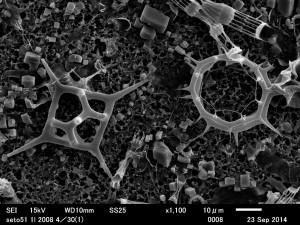University of Maine at Presque Isle Geology Professor Kevin McCartney is in the middle of his “Silicoflagellates Around the World” trip this fall—an adventure that includes stops in Japan, China and Poland. McCartney was awarded a University of Maine System Trustees Professorship for the Fall Semester to conduct this research trip.
McCartney departed on Sept. 2 for Japan, spent the second week of September at the International Diatom Symposium in Nanjing, China, returned to Japan for about three and a half weeks, and then, on Oct. 9, traveled to Poland. He will continue his research there until just before New Year’s Day, when he returns to northern Maine.
McCartney’s research specialty is the silicoflagellates, a group of single-celled algae that live in the oceans and build geometric skeletons made of quartz. According to McCartney, there are other groups such as the diatoms that are more important, but the silicoflagellates by themselves might provide a percent of the oxygen that the world breathes; thus, the group is important in its own right, but gets comparatively little attention from the scientific community. McCartney is one of very few scientists in the world who gives serious study to the group.
Over the last six years, McCartney has put together a group of scientists that has made a number of significant discoveries. This scientific group includes paleontologists, biologists and oceanographers whose specialties are in other microorganism groups but encounter silicoflagellates in their own research. Together these scientists have published a series of papers that covers aspects of silicoflagellates from their early evolution more than 100 million years ago to the present.
During a sabbatical in 2009 at the University of Nebraska-Lincoln, McCartney and his colleagues studied some of the earliest known silicoflagellates, recovered from sediments in northern Canada that dated to the latter portion of the Age of Dinosaurs known as the Cretaceous. They described 18 new species and two new genera of sillicoflagellates, one of which—Umpiocha—is named after the university. McCartney also discovered rare fossil double skeletons, an aspect of silicoflagellates that has received very little study. This sabbatical led to six scientific publications.
Silicoflagellate double skeletons are two skeletons that are connected prior to the cellular division of the living organism during reproduction. Once the cell splits, the two skeletons disarticulate. Modern double skeletons occur during algae blooms, but have seen little formal study. Fossil double skeletons are very rare as those that may have been deposited prior to separation are generally dismembered during the process of sample preparation.
In a 2012 sabbatical spent at the University of Szczecin in Poland, McCartney extended his Cretaceous research to sediments from Russia and Antarctica, and described three additional species and another genus in a paper that was published a few months ago. He also began cooperation with biologists in Japan, Italy, Australia and elsewhere to gain a better understanding of silicoflagellate double skeletons in the modern oceans. This sabbatical led to another six publications that are published or in press.
One paper that has just been published online, with a journal publication scheduled for the next few months, concerns two rare fossil double skeletons found in 40 million-year-old sediments, from a time known as the Eocene. One of these skeletons was discovered by McCartney while in Poland and the other was found by a graduate student colleague in Japan. These double skeletons are of an unusual configuration that suggests a more complicated evolutionary process that was previously known. That paper can be seen at http://dx.doi.org/10.1144/jmpaleo2013-024.
For the Trustees Professorship, McCartney will be continuing research on sediment and water samples from the Cretaceous, Eocene and modern oceans. The Trustees Professorship program is designed to assist UMS institutions in recognizing, rewarding, and retaining exceptional scholars and, in so doing, promoting excellence in teaching, scholarship, and research throughout the University of Maine System.
McCartney’s time in Japan was dedicated to work at the University of Yamagata, which is north of Tokyo. While in Japan, he worked with two graduate students who are studying fossil and modern silicoflagellates. He also worked with their professor, Richard Jordan, on modern silicoflagellates.
In China, McCartney gave a talk at the 23rd International Diatom Symposium, a five-day meeting with about 140 members from 18 nations attending. He chaired the initial session, on Evolution and Morphology, and then spoke during the second session. His talk dealt with research on both early silicoflagellate evolution in the Cretaceous Period and the occurrence of double skeletons. It incorporated the use of physical models to show how the early silicoflagellate double skeletons were configured. Since physical examples of such early double skeletons have yet to be observed, the use of the models—and in particular the inclusion of these into a scientific talk—was unusual and drew much interest.
While in Poland, McCartney and colleague Jakub Witkowski will also be studying the diatoms and silicoflagellates of Eocene age from the Blake Plateau, off the eastern coast of Florida. These samples, obtained from drill cores extracted from the deep sea in 1997, contain diatoms and silicoflagellates that have not previously been studied. Dr. Witkowski has done some very interesting work in interpreting past ocean environments and McCartney hopes that silicoflagellates can be better used to understand past climate change.
McCartney has always believed that teaching science and doing science go hand-in-hand; each inspires the other. While he is enjoying his research trip, he also looks forward to returning to northern Maine with new perspectives on science that can be related to his classes at UMPI.

